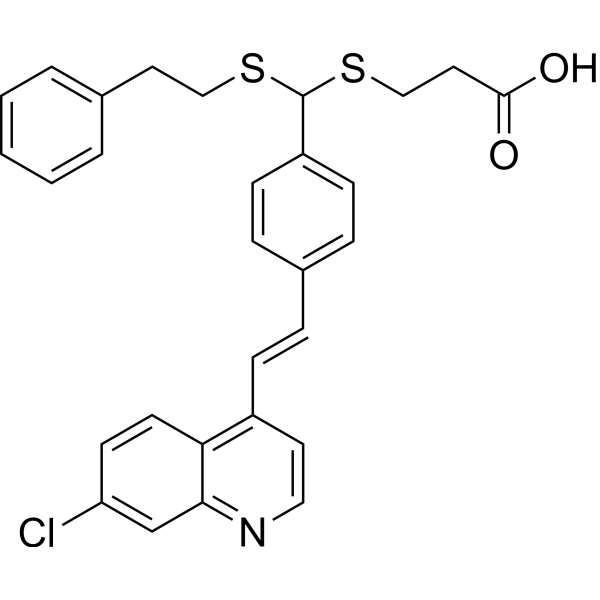Physicochemical Properties
| Molecular Formula | C29H26CLNO2S2 |
| Molecular Weight | 520.11 |
| Exact Mass | 519.109 |
| CAS # | 2449093-46-1 |
| PubChem CID | 134817239 |
| Appearance | Light yellow to yellow solid powder |
| Density | 1.317±0.06 g/cm3(Predicted) |
| Boiling Point | 718.4±60.0 °C(Predicted) |
| LogP | 7.8 |
| Hydrogen Bond Donor Count | 1 |
| Hydrogen Bond Acceptor Count | 5 |
| Rotatable Bond Count | 11 |
| Heavy Atom Count | 35 |
| Complexity | 663 |
| Defined Atom Stereocenter Count | 0 |
| SMILES | C1=CC=C(C=C1)CCSC(C2=CC=C(C=C2)/C=C/C3=C4C=CC(=CC4=NC=C3)Cl)SCCC(=O)O |
| InChi Key | PHENTWJNXGESKT-RMKNXTFCSA-N |
| InChi Code | InChI=1S/C29H26ClNO2S2/c30-25-12-13-26-23(14-17-31-27(26)20-25)9-6-22-7-10-24(11-8-22)29(35-19-16-28(32)33)34-18-15-21-4-2-1-3-5-21/h1-14,17,20,29H,15-16,18-19H2,(H,32,33)/b9-6+ |
| Chemical Name | 3-[[4-[(E)-2-(7-chloroquinolin-4-yl)ethenyl]phenyl]-(2-phenylethylsulfanyl)methyl]sulfanylpropanoic acid |
| HS Tariff Code | 2934.99.9001 |
| Storage |
Powder-20°C 3 years 4°C 2 years In solvent -80°C 6 months -20°C 1 month |
| Shipping Condition | Room temperature (This product is stable at ambient temperature for a few days during ordinary shipping and time spent in Customs) |
Biological Activity
| Targets | IC50: 24.5 µM (ATG4B); Kd: 16 μM (ATG4B)[1] |
| ln Vitro | In all four cell lines, endogenous LC3B-II and protein p62 levels increase in a dose-dependent manner upon treatment with LV-320 (0-120 µM; SKBR3, MCF7, JIMT1, and MDA-MB-231 cells)[1]. Treatment with -320 (120 µM; 48 hours; MDA-MB-231 cells) causes an increase in LC3B-II, suggesting that LV-320 inhibits autophagic flux[1]. |
| ln Vivo | Treatment with LV-320 (100-200 mg/kg; oral gavage; three times over two days; GFP-LC3 mice) causes a 104 µM liver level and a 169 µM terminal blood level. Compared to controls, mice treated with LV-320 exhibited a considerably higher accumulation of GFP-LC3 puncta expression. Animals treated with LV-320 also exhibit an increase in LC3B-II protein. At any dosage, the therapy does not significantly harm mice[1]. |
| Cell Assay |
Western Blot Analysis[1] Cell Types: SKBR3, MCF7, JIMT1, and MDA-MB-231 cells Tested Concentrations: 0 µM, 25 µM, 50 µM, 75 µM, 100 µM, or 120 µM Incubation Duration: Experimental Results: Resulted in a dose-dependent increase in endogenous LC3B-II and protein p62 levels in all four cell lines. Cell Autophagy Assay[1] Cell Types: MDA-MB-231 cells Tested Concentrations: 120 µM Incubation Duration: 48 hrs (hours) Experimental Results: Blocked autophagic flux. |
| Animal Protocol |
Animal/Disease Models: GFP-LC3 mice (females, 9-14 weeks)[1] Doses: 100 mg/kg or 200 mg/kg Route of Administration: po (oral gavage); three times over two days (pharmacokinetic/PK study) Experimental Results: Terminal blood levels were 169 µM and liver levels were 104 µM. LC3B-II protein level was also increased. |
| References |
[1]. A new quinoline-based chemical probe inhibits the autophagy-related cysteine protease ATG4B. Sci Rep. 2018 Aug 3;8(1):11653. doi: 10.1038/s41598-018-29900-x. |
Solubility Data
| Solubility (In Vitro) | DMSO : 135 mg/mL (259.56 mM) |
| Solubility (In Vivo) |
Solubility in Formulation 1: ≥ 2.25 mg/mL (4.33 mM) (saturation unknown) in 10% DMSO + 40% PEG300 + 5% Tween80 + 45% Saline (add these co-solvents sequentially from left to right, and one by one), clear solution. For example, if 1 mL of working solution is to be prepared, you can add 100 μL of 22.5 mg/mL clear DMSO stock solution to 400 μL PEG300 and mix evenly; then add 50 μL Tween-80 to the above solution and mix evenly; then add 450 μL normal saline to adjust the volume to 1 mL. Preparation of saline: Dissolve 0.9 g of sodium chloride in 100 mL ddH₂ O to obtain a clear solution. Solubility in Formulation 2: ≥ 2.25 mg/mL (4.33 mM) (saturation unknown) in 10% DMSO + 90% Corn Oil (add these co-solvents sequentially from left to right, and one by one), clear solution. For example, if 1 mL of working solution is to be prepared, you can add 100 μL of 22.5 mg/mL clear DMSO stock solution to 900 μL of corn oil and mix evenly. (Please use freshly prepared in vivo formulations for optimal results.) |
| Preparing Stock Solutions | 1 mg | 5 mg | 10 mg | |
| 1 mM | 1.9227 mL | 9.6134 mL | 19.2267 mL | |
| 5 mM | 0.3845 mL | 1.9227 mL | 3.8453 mL | |
| 10 mM | 0.1923 mL | 0.9613 mL | 1.9227 mL |
